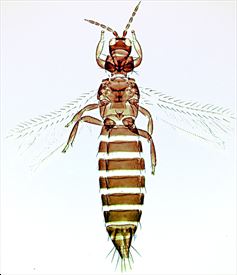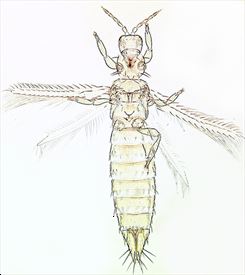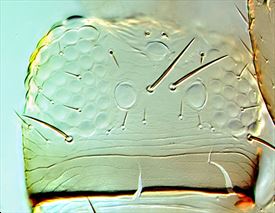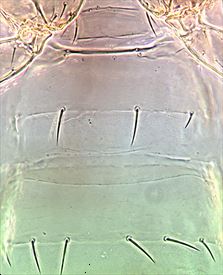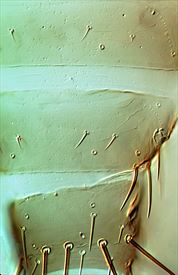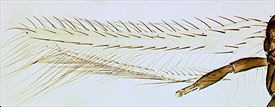Distinguishing features
Both sexes fully winged. Female either yellow with faint shadings on tergites and antennal segments VI–VIII brown, or brown with pronotum, tibiae and tarsi paler, and antennae brown with segments III–V yellow at base; fore wings pale with dark setae. Antennae 8-segmented; III–IV each with sense cone forked, VIII longer than VII. Head wider than long; 3 pairs of ocellar setae, pair III arising close together between anterior margins of hind ocelli and as long as side of ocellar triangle; postocular setae pair IV as long as distance between hind ocelli. Pronotum with 5 pairs of major setae; anteromarginal setae slightly shorter than anteroangulars, one pair of minor setae present medially between posteromarginal submedian setae. Metanotum with 2 pairs of setae at anterior margin, campaniform sensilla absent. Hind coxae with group of microtrichia on dorsal surface. Fore wing with 2 complete rows of veinal setae. Tergites VI–VIII with paired lateral ctenidia, on VIII anterolateral of spiracle; posteromarginal comb on VIII not developed. Sternites III–VII without discal setae.
Male similar to female but smaller; tergite VIII with a few teeth laterally on posterior margin; sternites III–VII with broadly transverse pore plate.
Related species
Frankliniella species all have a pair of setae in front of the first ocellus, a complete row of setae on both veins of the fore wing, and a pair of ctenidia on tergite VIII situated anterolateral to the spiracles. Most of the 230 described species are known only from the neotropics, but F. schultzei, and F. occidentalis have been widely introduced around the world (Kirk & Terry, 2003). F. schultzei is exceptional within the genus because of the close placement of ocellar setae III within the ocellar triangle, and the absence of a posteromarginal comb on tergite VIII. However, as with occidentalis, molecular diversity has been demonstrated within schultzei, but similarly without any demonstration of host plant associations differing, or any other biological differences, between the sibling species (Hereward et al., 2017).
Biological data
This is a highly polyphagous pest, feeding and breeding in flowers and on leaves, however, it also feeds on leaf mites of which it can be a useful biocontrol agent. It is an important vector of tospoviruses on many crops, with the dark form typically a vector, although in the Bowen region of northeastern Australia the pale form is the major tospovirus vector on crops.
Distribution data
Not recorded from New Zealand, but considered a high risk potential invader. This species is widespread around the world in tropical and subtropical areas, and is probably originally from South America.
Family name
THRIPIDAE, THRIPINAE
Species name
Frankliniella schultzei (Trybom)
Original name and synonyms
Physopus schultzei Trybom, 1910: 151
Euthrips gossypii Shiraki, 1912: 65
Frankliniella sulphurea Schmutz, 1913: 1019
Frankliniella delicatula Bagnall, 1919: 263
Frankliniella trybomi Karny, 1920: 36
Frankliniella persetosa Karny, 1922: 97
Frankliniella dampfi Priesner, 1923: 64
Frankliniella tabacicola Karny, 1925: 4
Frankliniella dampfi interocellaris Karny, 1925: 126
Frankliniella anglicana Bagnall, 1926: 281
Frankliniella africana Bagnall, 1926: 100
Frankliniella aeschyli Girault, 1927: 2
Parafrankliniella nigripes Girault, 1928: 4
Frankliniella paucispinosa Moulton, 1933: 128
Frankliniella kellyana Kelly & Mayne, 1934: 20
Frankliniella dampfi f. nana Priesner, 1936: 85
Frankliniella lycopersici Andrewartha, 1937: 163
Frankliniella favoniana Priesner, 1938: 30
Frankliniella pembertoni Moulton, 1940: 247
Frankliniella clitoriae Moulton, 1940: 248
Frankliniella ipomoeae Moulton, 1948: 95
Frankliniella schultzei nigra Moulton, 1948: 100
References
Hereward J, Hutchinson JA, McCulloch GA, Silva R & Walter GH (2017) Divergence among generalist herbivores: the Frankliniella schultzei species complex in Australia (Thysanoptera: Thripidae). Arthropod-Plant Interactions, Springer. DOI 10.1007/s11829-017-9543-3
Hoddle MS, Mound LA, Paris DL (2012) Thrips of California 2012. CBIT Publishing, Queensland. http://keys.lucidcentral.org/keys/v3/thrips_of_california/
Thrips_of_California.html
Kirk WDJ & Terry LI (2003) The spread of the western flower thrips Frankliniella occidentalis (Pergande). Agricultural and Forestry Entomology 5: 301–310.
Nakahara S. (1997) Annotated list of the Frankliniella species of the world (Thysanoptera: Thripidae). Contributions on Entomology, International 2: 353–389.
Wang C-L, Lin F-C, Chiu Y-C, Shih H-T (2010) Species of Frankliniella Trybom (Thysanoptera: Thripidae) from the Asian-Pacific Area. Zoological Studies 49: 824–848.

